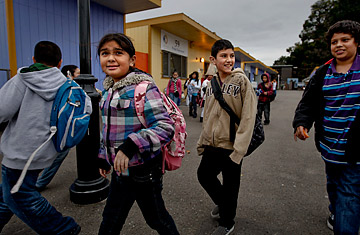
Fourth and fifth graders at Achieve Academy, heading home after school in Oakland, Calif., on Feb. 4, 2010
On May 10, when President Obama traveled to El Paso, Texas, to again make the case for immigration reform, he talked about the tragedy of a policy that denies children the chance to earn a college education because of how their parents entered the country. But in many ways, we've already failed our fastest-growing ethnic group, Hispanic Americans, long before they reach college and regardless of whether they were born here or not.
Hispanics now constitute 16% of the U.S. population, and the Census Bureau estimates they will account for 30% in 2050. This obviously means the number of Hispanic students in our public schools is increasing as well. From just 2001 to 2008, the percentage of Hispanics in public schools grew from 17% to 21%. In Texas, Hispanics already make up the majority of public school students.
You'd think those numbers would grab the attention of policymakers and educators and spur action — but you'd be wrong. Our public schools are woefully unprepared to deal with the fastest-growing ethnic group in the U.S. Only 17% of Hispanic fourth-graders score proficient or better on the National Assessment of Educational Progress (a test given to samples of students each year) while 42% of non-Hispanic white students do. Nationally, the high school graduation rate for Hispanics is just 64%, and only 7% of incoming college students are Hispanic, according to the Alliance for Excellent Education.
These two tectonic issues — our rocketing Hispanic population and the inadequate education of Hispanic students — are on a collision course that could either end in disaster or in another story of successful assimilation in America. The stakes are clear: how we meet this challenge will impact our politics, economy and our society.
The Hispanic population boom understandably caught some states, communities and educators flat-footed. Places with few, if any, Hispanic students just a few years ago now have sizable populations. This week, the Wall Street Journal reported that in North Carolina 16 of 100 counties are more than 10% Hispanic. Just four were in 2000. In Harrisonburg, Va., a sleepy university town in the Shenandoah Valley, about 40% of students in the city schools are Hispanic English-language learners, a figure that has soared over the past decade.
Still, the demographic projections are so well known that no one should be surprised. And some states are responding more effectively than others. Florida, for example, has seen a steady increase in the performance of its Hispanic students over the past decade. In Florida, 31% of Hispanic students score proficient or better on the state version of the National Assessment of Educational Progress, making Florida a national leader.
So what should policymakers and educators do?
For starters, many of the issues that adversely affect Hispanic students are the same issues that hamstring minority students overall. These students are less likely to have the most-effective teachers or have access to a strong curriculum and college-preparatory classes and more likely to attend poorly funded schools. In that way, the Hispanic agenda is no different than the more general good-schools agenda. In Florida, the rising tide from a host of education reforms seems to have lifted all boats.
But there are more unique issues too. There are 4 million Hispanics in public schools whose primary language is not English (and 75% of them were born in the U.S.) Thankfully, dead-end bilingual programs that trap students while teaching them little are increasingly a thing of the past. However, there is still too little training, curriculum and support for teachers of English-language learners. A 2002 analysis by the Department of Education found that 1 in 3 teachers working with these students lacked academic training or proper certification.
There is also too little in the way of high-quality tests for students learning English — both to measure their progress and ensure that schools are serving them well. I saw this firsthand when the Virginia Board of Education, on which I was serving at the time, needed to adopt a new assessment for English-language learners. The lack of proven models was appalling. Despite the federally funded effort to develop common assessments, this remains a prime opportunity for investment from foundations or the private sector.
Educators and policymakers must think more creatively about migrant students as well, who travel with their parents as they look for seasonal work. For instance, Sisters of Mercy, an order of nuns who focus on the poor, ran a portable school for migrant students for seven years that moved between Fremont, Ohio, and Plant City, Fla., providing a continuous education. Today, technology makes such anytime and anywhere approaches to education even more feasible and scalable.
We hear a lot of talk from our national leaders about how our schools must do better to keep the country economically competitive. Given the numbers, doing a better job with Hispanic students is a key part of any competitiveness strategy. In fact, if we're serious about producing more scientists, engineers and innovators than we do today, currently underserved populations are the obvious place to look. More fundamentally — given our national creed — if we want to do more than pay lip service to diversity and opportunity for all, this is a vital place to start.
Andrew J. Rotherham, who writes the blog Eduwonk, is a co-founder and partner at Bellwether Education, a nonprofit working to improve educational outcomes for low-income students. School of Thought, his education column for TIME.com, appears every Thursday.
